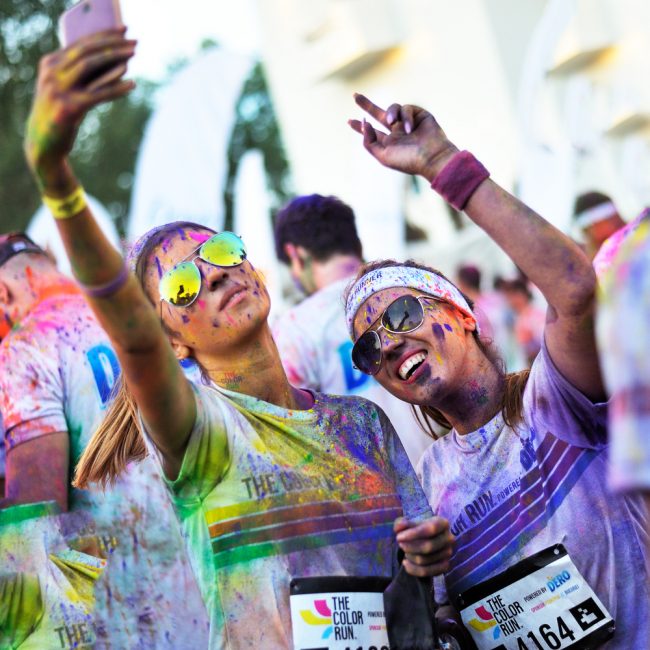CONTENTS

Running Your First Marathon – Motivation and Training Tips
Listen ladies and gentlemen, you need to run a marathon.
Even if you do not see yourself as a runner, or consider running to be a tool in your bag of exercises, you simply must run a marathon.
The truth is, we are all runners. Yes, even you|! We evolved to be runners.
It is as the original anti-establishment, carve-your-own-path hipster, Ralph Waldo Emerson said, “First be a good animal.” To be a good animal, you must run, just like all of the two-and four-other legged animals do. For millions of years, our ancestors ran to eat, to not be eaten, and to have fun. You cannot get around the fact that running is in your DNA. Let’s not deny science.
Let’s run and live as we were meant to.
The Marathon Is THE Gold Standard Running Achievement
The 26.2 miles of the marathon are a challenge.
The marathon distance was set 2500 years ago when Pheidippides ran approximately 26 miles to get to Athens to share the great news that the invading Persians had been defeated.
Ever since, this race length has become the touchstone that connects everyone who completes a marathon with that original running Greek Major Boss MoFo.
When you do a marathon, you are plugging into that historical power!
Running Is the Ultimate Human Sport
The act of running is simple.
This is something we understand even as children. Watch a group of children outside, and you will see that they love to run. Most adults have forgotten just how natural and fun running can be. When you challenge yourself to prepare for your marathon, you will rediscover your inner child along with the primal joy of running.
Running a Marathon Will Kick You Out of Your Comfort Zone
Preparing for a marathon will boot you right out of your comfort zone.
Imagine how powerful of a kick you will get from completing a marathon? When is the last time you truly challenged yourself? Do you really want to be living the exact same life six months from now?
No, you do not. Start running now!
Benefits Reaped from Running a Marathon Will Touch Every Aspect of Your Life
The Groom+Style Team first heard our favorite mantra, “discipline is freedom,” on US Navy Seal Jocko Willink’s podcast.
It means that as you are better able to control your energy, thoughts, and actions, the better your life will be and the more freedom you will have to live your life YOUR WAY.
Preparing for a marathon is one of the best ways to build self-discipline.
The shortest training program for a marathon typically lasts between 18 to 20 weeks. This means that for four or five months, you will be putting on your running shoes four to six times a week and heading out the door for a run. That is discipline.
As you strengthen your will in one area (running races in this case), you will soon learn that this newly acquired strength will improve your life in other areas. For example, once you get into the routine of going for long runs on Saturdays, your habit of going out drinking with the lads and lasses from the office on Friday evenings will lose its charm.
Moreover, your newly found self-discipline will thread its roots into parts of your life that have no connections to running whatsoever.
For example, if you have earned a bad reputation at work for continuously arriving late, you may find you can build a new reputation as being the person who arrives 10 minutes early each day simply by deciding to do so – just as you decided to run a marathon.
The great Scotsman William Barclay wrote, “Endurance is not just the ability to bare a hard thing, but to turn it into glory.”
We will not lie and say that training and running a half or full marathon is easy. It will SUCK at times, but it is that suckiness of the running race experience that is one of the primary reasons you must become a marathon runner. Once you are an “official marathon runner” every other challenge in your life will seem more manageable.
The confidence you will obtain from finishing that 26.2 miles will flow through to all areas of your life!
Get Fit
We forgot to mention that training to run 26.2 miles will make you fit!
Fat will melt off your body with each running step you take, while you strengthen your central nervous and cardiovascular systems.
Being fit is wonderful, but for many runners it is all of the other positives that are realized by setting and reaching goals again and again that really draws them to running day after day.
How to Complete Your First Marathon Even if You Have Not Run a Single Step in Years
In 2015, according to Running USA, 509,000 runners completed marathons in the United States.
If all these people ran a marathon, surely, with a bit of training and the right running program, you too can complete a running race.
One of the keys is to find the right marathon running program and marathon for you!
Marathon Running Programs
Jeff Galloway, a former member of the USA Olympic running team, has had great success training people from all walks of life to complete half and full distance marathons. For true beginners, he suggests a walk/run method that focuses on time-on-feet instead of distance.
His website is loaded with great information on training for your first half or full marathon.
The walk/run method is especially effective for runners who are starting out.
Depending upon your current abilities, you may start out with a ratio as easy as 10 seconds of running followed by 30 seconds of walking for a prescribed period. If you are fairly fit, your starting run/walk ratio may be something around four minutes of running followed by 30 seconds of walking.
The key to this method is starting the walking intervals before you begin feeling tired.
Marathon Training Programs on your Phone
There are some very effective and user-friendly apps for both iPhone and Android phones that you can use to train for your first half or full distance marathon.
One of the best is the Marathon Trainer app, while the incredible training website MapMyRun has a wide variety of run training apps for races of different lengths. Another product that might assist you on your path to becoming a marathon runner is a gps running watch.
Going Farther – Staying Healthy, Injury Free and Avoiding Burnout
As the weeks roll by, you will want to run further and further.

Be careful when adding distance to your weekly totals. The rule of thumb is to increase your weekly mileage by no more than 10% a week for three straight weeks, then take an easy week during which you decrease your weekly total by 10-20%. An example would be:
● Week 1: 10 miles
● Week 2: 11 miles (a 10% increase)
● Week 3: 12 miles (a 10% increase)
● Week 4: 10 miles (a 20% decrease)
● Week 5: 13.5 miles (a 10% increase from week 3)
● Week 6: 15 miles (a 10% increase)
● Week 7: 16.5 miles (a 10% increase)
● Week 8: 13 miles (a 20% decrease)
By increasing your mileage at this pace, then backing off every four weeks, your body has time to adjust to the new workload and stay injury free.
The other key to avoiding injuries is ensuring that you take care of yourself while you are not running. This means you need to stretch two or three times a week, and perhaps get a sports massage every couple of weeks or once a month.
Doing a Yoga class every now and then is a great complement to the stresses running can place on your body. Listen to your body, and take care of budding issues before they bloom into problems that keep you off your feet for weeks or even months.
It is beyond the scope of this article, but you will also need to pay close attention to your dietary requirements and protein intake, to help you reach your goal of running a marathon.
Long Slow Distance
Hang around distance runners long enough and you will hear about the magic of LSD-Long Slow Distance runs. Weekly or biweekly LSD runs are the most important runs you can do while training for your first marathon.
By the end of your training program you should have run at least one LSD run of 20 miles or more.
Finding the Right Marathon for You

There are thousands of marathons on the marathon calendar each year.
To find the right event for you, look for marathons that are within your budget; easy to enter as some running events fill within minutes once registration opens; have achievable cut-off times; are on similar terrain and elevation on which you train; in mild or cool climates; and have aid stations every few miles.
Finding Additional Motivation
Following a documented running program will keep you motivated, as once plans are written down, they seem much more real than if we just kept them in our heads. Make sure your running program is laid out in full in your phone, posted on your fridge, or written in your training diary.
Make it real!
In addition, there are running groups and clubs in just about every city and town in the world. Running with friends or groups is a great way to get yourself out on those days you just don’t feel like it.
It’s also a great way to meet people after getting out of college.
Newcomers to the sport have had success motivating themselves by raising money for a cause they believe in. Do you have any causes you are passionate about? If so, this can make the run about more than yourself, which is one of the most powerful ways to stay on track.
Bottom Line to Completing Your First Marathon Distance Race
You do need to run a marathon. Completing a marathon is an accomplishment that will impact all areas of your life, and a feat that will stay with you forever.
If it turns out that you genuinely enjoy running, this bucket list accomplishment will have given you an enjoyable activity that you can continue to share with your friends, partner, and children.
If you really get the long distance running bug, just keep in mind that an ultra marathon is just five miles longer than a marathon (31 miles). How would you like to be an ultra marathoner? Yeah, that’s what I thought. Let’s get running.
Before Starting
As always, you must remember to review your plans and your current health status with your doctor before starting any new workout program.



